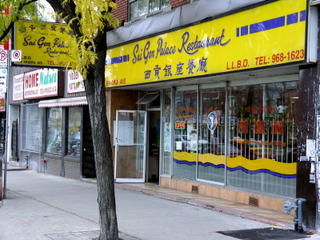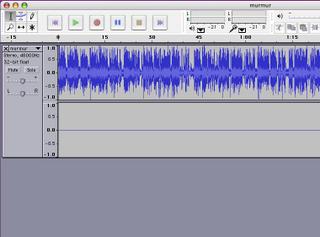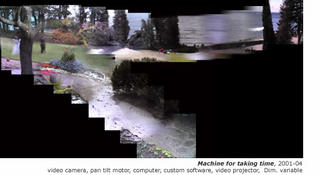Saturday, October 29, 2005
Tuesday, October 25, 2005
Reading for next week : marooned in the moment
READ FOR NEXT CLASS (November 1st). This excellent article about the Toronto Memory Group introduces the next section of Virtual Communities. Amnesics lose their ability to remember recent events and to plan for the future. The Toronto Memory Group - including users, scientists and psychologists - is creating digital tools to address the problems of disorientation that amnesics experience. Virtual Communities will contribute to this research, using our skills as artists and designers. "Marooned in the Moment" was originally published in the Globe and Mail, and is featured online in the current issue of The Canada Foundation for Innovation's newsletter. PLEASE POST COMMENTS ON THIS ARTICLE.
Audacity recording & editing guide
This guide will give you a quick overview of all the basics you need to know about audio editing with Audacity. Note: If you want to export your audio from audacity as an MP3 file, you will need to download Lame Lib - an MP3 encoder from: http://spaghetticode.org/lame/ (for Mac users) and http://mitiok.free.fr/ (for PC users). Audacity supports wav file exports.
(edit: fixed the link... had a typo - A7)
Monday, October 24, 2005
Murmur Spadina - Sai Gon Palace
Here is my Murmur recording. It is a story about the Sai Gon Palace Restaurant, and meeting your mother-in-law for the first time.

SaiGon recording: Listen Here
A7
Saturday, October 22, 2005
Using Audacity to prepare your audio for Murmur
Hi all,
I thought I'd write another "how-to" post, to help out with the audio processing for Murmur. I'm going to assume that everyone knows how to record, and import their audio to he computer, so this little guide shows you what to do after you have the file on your computer. First, a little background on why you may need to process your audio before it can be used for the Murmur project. Sorry for the geek speak that follows, but it helps to understand a bit more.
Sound "pitch" (i.e. whether a sound is low, like a bass, or high, like a flute) is measured in Hertz. Low sounds have low Hertz (100Hz) and high sounds have high Hertz (10000Hz). The human ear can hear sounds roughly between 20Hz and 20000Hz. That's why humans can't hear dog whistles for example, since they create sound above 20000Hz (dogs can hear up to about 40000Hz).
So, how does that relate to the project you ask? Because what WE hear is not neccesarily what the recording device picks up, and more importantly, NOT how a telephone works. Microphones vary greatly in the frequencies they pick up, and cheaper mics can exaggerate some frequencies more than others. In general, cheap mics will boost low frequencies, and cut high frequencies. This makes for a "boomy" recording, especially when recording a male voice, as the male voice is generally in the range of 150Hz. Under normal circumstances, this is not a big issue. However, it gets tricky when playing it through a telephone. Most telephones only transmit sound in the range of 300Hz to 3000Hz. And that's why it's important to process your audio for it to sound good on a telephone. You need to cut out that low rumbling streetcar sound and cut out the high pitched wind hiss in order for the voice to sound right.
So this is how you do it:
Start up Audacity (free download from http://audacity.sourceforge.net/ ). Open the file you recorded. Audacity will let you import WAV, AIF, or MP3 files. Once the file is loaded, make sure the sound is actually in stereo, or in mono. If the file is in stereo but the sound is mono, you will only be getting sound from one speaker (i.e. not good). In that case, the file will look like this (notice the straight line in the lower window):

If your file is ok (already mono or proper stereo) you can skip to the next block of text. Otherwise, you can change it by clicking on the file name in the top left corner of your sound file (in the picture above, the word Murmur next to the "X"). Click your file name and select "Split Stereo Track". You will then have 2 seperate files. Close the one that has no sound (click the "X"). Then, in the remaining sound file, click the name again and select mono, as in the picture below:

Now to process the sound. Click "Edit" -> Select.. -> All. You should now have your file highlighted. Click "Effect" -> High Pass Filter. Enter a frequency between 400-600 and click ok. Then click "Effect" -> Low Pass Filter. Enter a frequency between 2800-3500 and click ok.
Finally, we will normalize the sound. Normalizing the sound ensures that the parts where the person was talking soft will be about the same volume as when they were talking loud. Click "Effect" -> Normalize, and click ok. Your sound should now be "telephone ready". BUT, by applying all those filters you may have lowered the volume of the sound. If you think it's too faint, click "Effect" -> Amplify, and click ok. Now save the file first so you don't lose anything, then export it as MP3 if you like (or convert to mp3 by another method of your choice).
Phew! Hope all this crazy nerdy info helps a few people to get better sound. :) Good luck.
A7
Friday, October 21, 2005
Assignment #2 is due next week
This project is due week 7!
For next week, be sure to:
1) test your audio (see below)
2) record your test results - for hand-in
3) post your audio to the blog - for presentation in class & marking
4) post a picture of your chosen site with your audio posting
5) bring in any research notes you made
6) bring in your signed release sheet (there is a pdf copy on my courses if you need another one).
Tuesday, October 18, 2005
Assignment #2 [murmur] on Spadina Project - testing
Before you post your audio, please test it. follow the link in this post or go to: www.murmurtoronto.ca/audiotest/
Upload your file and then you will get a call back on your phone to test the file. Check to see that the audio is clear! Make notes about the test, and any adjustments that you make to your audio, for hand-in. You may want to test it more than once, asking someone who is not familiar with the story to listen. Make any adjustments necessary to your file before posting it on the blog.
You will be presenting your [murmur] story in class, and handing in your test notes and any research notes you may have made. Don't forget to bring along your signed release form. Shawn from [murmur] will be attending our presentations on Tuesday!
Monday, October 17, 2005
[murmur] on Spadina

[murmur] launches on Spadina Oct 20th at Grossman’s Tavern
Exciting news about the ongoing [murmur] project! Your [murmur] stories will be considered for inclusion in this exciting new work.
Please join [murmur] this Thursday Oct 20th at Grossman's Tavern (379 Spadina Avenue at Cecil) from 6-9pm for a (free) reception celebrating the launch of our Spadina project with 50 new sites along the street. We've been recording Torontonians over the past few months telling parts of Spadina's story in their own words. Some of the stories are anecdotal, other times historic, but always heartfelt. Listen to a tale of sneaking into the Pickford Theatre at Queen and Spadina in the 1920s, ghost stories at the Bright Pearl restaurant and what it's like to live on the 22nd floor, high above the street at 666 Spadina.
[murmur] on Spadina is part of Toronto's Live With Culture program (livewithculture.ca), and we have partnered with the Chinese Canadian National Council of Toronto (ccnc.ca/toronto) to help gather stories from the local Chinese community. If you feel a group is underrepresented in Toronto's history, please put us in contact with the people who can help us find those storytellers. But do join us on Thursday at one of Toronto's historic music venues (and [murmur] story site) and pick up our brand new Spadina map/guide illustrated by Marlena Zuber (the artist behind both our Kensington and Annex maps).
David Rokeby exhibition

If you're interested in David Rokeby after seeing the show at Interaccess, there will be a new exhibition of his work opening this week.
David Rokeby - Time and Place
October 19 to December 31, 2005
Opening reception Wednesday, October 19, 5-8 pm
Pari Nadimi Gallery
254 Niagara Street
Toronto, ON M6J 2L8 Canada
gallery hours: Tuesday-Saturday 11-5 pm
Tel: 416.591.6464
www.parinadimigallery.com
Time is one of artist David Rokeby s primary materials. Time as the landscape traversed by memory. Time that is the difference between a slap and a caress. Time liberated from determinate sequence. Time folded upon itself, events layering into shapes and forms.
For Machine for Taking Time (2001-4), David Rokeby set up a system that recorded a daily panorama of 1000 images of Gairloch Gardens for 3 years. The installation continuously draws from its million images to construct a seamlessly flowing pan across a garden unanchored in time. Seasons melt into each other, Sunday painters and weddings appear and fade, a year flickers by like a shift in light. Machine for Taking Time was the first in an ongoing series of works that attempt to record the activities and the passage of time in particular places. Rokeby will continue this exploration, using the unlimited patience of the computer and surveillance camera to capture and record the ephemera of passing time, drawing out patterns, forms and traces invisible to our human eyes rooted in human time.
David Rokeby has been creating interactive sound and video installations with computers since 1982. His early work Very Nervous System(1982-1991) is acknowledged as a pioneering work of interactive art, translating physical gestures into real-time interactive sound environments. Very Nervous System was presented at the Venice Biennale in 1986, and was awarded the first Petro-Canada Award for Media Arts in 1988 and Austria's Prix Ars Electronica Award of Distinction for Interactive Art in 1991.
Several of his works have addressed issues of digital surveillance. Watched and Measured(2000) was awarded the first BAFTA award for interactive art from the British Academy of Film and Television Arts in 2000. Other works engage in a critical examination of the differences between human and artificial intelligence. The Giver of Names (1991-) and n-cha(n)t(2001) are artificial subjective entities, provoked by objects or spoken words in their immediate environment to formulate sentences and speak them aloud. David Rokeby's installations have been exhibited extensively in the Americas, Europe and Asia.
Wednesday, October 12, 2005
Recording Media
I got an email from Michael Page, another professor at OCAD in the integrated media section, regarding cheap recording media. Since we are recording audio, and some students may be using the mini-dv camera method, I thought the information might be helpful in saving some cash. Here is his email:
---------------
Some students have asked about where to purchase miniDV tapes and DVDs inexpensively. One place, on College st. called Factory Direct (290 College st.) advertises sony mini-DV tapes for $39.98 for 10 tapes.
DVD media +R or -R is $29.98 for 100 disks. There is no reason to believe that this media won't last as long as any other blank media, however, just in case...
Sony DVDs can be used as permenent archives at $29.99 for 50 disks.
Get together with your classmates and buy some media.
SAVE OFTEN
---------------
A7





